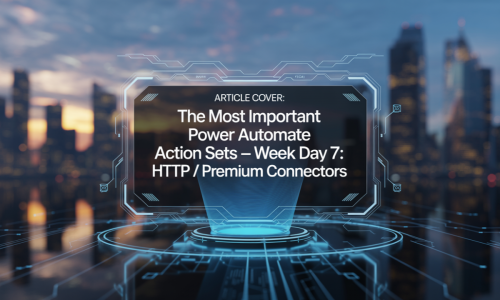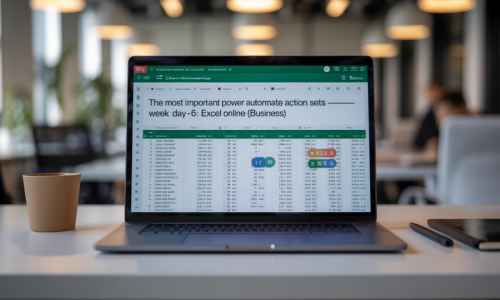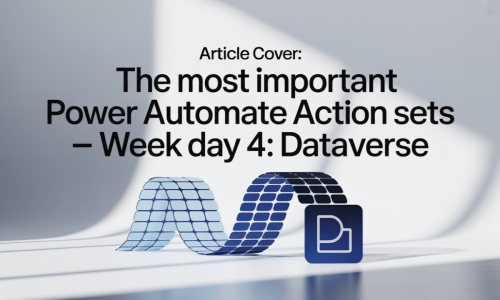Power Platform PM Week Day 5 – Agile vs. Waterfall in Power Platform: Choosing the Right Mix

-
Admin Content
-
Oct 27, 2025
-
132
When it comes to delivering solutions on Microsoft’s Power Platform, project managers are faced with an important decision: how to manage the project effectively. Traditional project management approaches like Waterfall have been around for decades, offering predictability and structure. Meanwhile, Agile has emerged as a dynamic alternative, emphasizing flexibility and iterative development. In the context of Power Platform projects, which often balance business urgency with technical complexity, choosing the right mix between Agile and Waterfall can make the difference between success and frustration. This article explores both approaches, their advantages and challenges, and how project managers can find the best blend for Power Platform delivery.
Understanding the Waterfall Approach in Power Platform Projects
The Waterfall method is characterized by a sequential flow—requirements are gathered, designs are created, development is executed, and testing and deployment follow in order. For Power Platform projects, this model provides a structured way to define clear goals and deliverables from the start. Large enterprise implementations, such as migrating legacy systems or building compliance-heavy solutions, often benefit from this approach because it ensures all requirements are agreed upon before development begins.
However, the rigidity of Waterfall can sometimes hinder innovation within Power Platform. Business needs frequently evolve during development, and locking requirements early may result in rework or dissatisfaction later. Since the Power Platform is designed for rapid solution building, a purely sequential model can feel slow, especially when stakeholders are eager to see tangible results quickly.
Despite these challenges, Waterfall still has its place. Its structured documentation, strong governance, and emphasis on risk management are invaluable for highly regulated industries. For organizations that require predictable timelines and budgets, Waterfall provides a sense of security that Agile alone may not always offer.
Embracing Agile in the Power Platform World
Agile thrives on adaptability, delivering solutions in iterative sprints that provide stakeholders with working features early and often. In Power Platform projects, this is particularly powerful because the platform’s low-code/no-code environment allows rapid prototyping and continuous feedback. Agile enables business users to actively participate in the development cycle, seeing and testing features almost as soon as they are built.
This approach aligns well with the Power Platform’s spirit of democratizing app development and empowering citizen developers. Business users can collaborate with professional developers to fine-tune solutions in real time, creating a product that better fits actual needs. Agile encourages learning, flexibility, and continuous improvement, which leads to higher user satisfaction and greater alignment with organizational goals.
That said, Agile is not without challenges. It requires strong collaboration, a culture open to change, and stakeholders who are available to provide feedback consistently. Without proper governance, Agile projects can risk scope creep or end up with fragmented solutions. In organizations unaccustomed to iterative processes, the shift to Agile can be disruptive and confusing.
Finding the Right Balance: Hybrid Approaches
For many Power Platform projects, the best answer isn’t strictly Waterfall or Agile, but rather a hybrid approach that combines the strengths of both. Hybrid models often apply Waterfall principles at the higher levels—such as defining overall project goals, governance, and compliance needs—while leveraging Agile techniques for execution and delivery. This allows teams to set clear expectations while still adapting to evolving business needs.
For example, a project might start with a Waterfall-style requirements phase to capture compliance obligations, budget constraints, and key milestones. Once these are defined, the development phase could adopt Agile sprints to deliver features incrementally. This way, stakeholders see progress regularly without sacrificing the structure needed for accountability and oversight.
Hybrid approaches are especially effective in larger organizations, where governance cannot be overlooked but flexibility is still critical. By tailoring the methodology to fit both organizational culture and project scope, project managers can unlock the full potential of the Power Platform while managing risk effectively.
Practical Tips for Choosing the Right Mix
The decision between Agile, Waterfall, or a hybrid approach depends on several factors, including project size, organizational culture, stakeholder engagement, and regulatory requirements. Project managers should consider the following practical tips when choosing their approach:
- Evaluate project complexity – Large-scale or compliance-heavy projects may lean more toward Waterfall, while smaller, user-driven projects benefit from Agile.
- Understand stakeholder availability – If stakeholders are committed and available for frequent feedback, Agile is ideal. If not, a more structured approach may be safer.
- Assess organizational readiness – Agile requires a cultural shift. Ensure the team and leadership are prepared to embrace iteration and flexibility.
- Leverage Power Platform strengths – Use Agile to exploit the platform’s rapid prototyping and iteration capabilities, even within a larger structured plan.
- Don’t fear a hybrid model – Blending methodologies can often achieve the best of both worlds, delivering structure while remaining adaptable.

Summary
Delivering successful solutions on the Power Platform requires more than just technical expertise—it requires thoughtful project management. While Waterfall offers structure and predictability, Agile brings flexibility and responsiveness. The most effective project managers recognize that no single approach fits all scenarios. Instead, they adapt their methodology to balance governance with agility, creating a delivery framework that reflects both organizational requirements and the dynamic nature of the Power Platform.
By choosing the right mix between Agile and Waterfall, project managers can maximize efficiency, foster innovation, and ultimately deliver solutions that empower their organizations to achieve more with the Power Platform.





